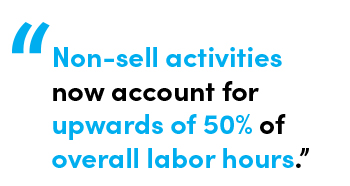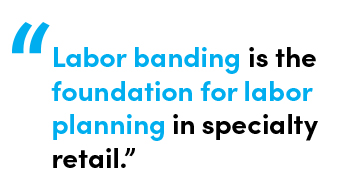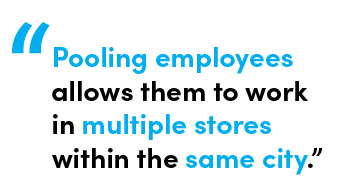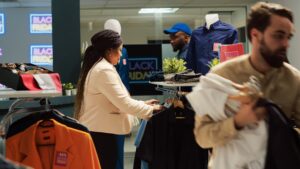Blog Post
Revisit and Revamp Your Approach to Retail Labor Planning
October 7, 2024 in Thought Leadership, Workforce Management

Stores have been tasked with many new activities to support digital sales. Store performance is also being measured differently – through a combination of brick-and-mortar and digital sales. These changes have impacted labor planning in a big way. Retailers need to consider that legacy labor planning methods may no longer fit with the current operation. There has never been a better time than now to revisit and revamp your labor models.
Below, we provide different labor planning methods to consider. These methods take into account the retail trends of today. These trends include changing customer behaviors, and the new sell and non-sell activities that have emerged recently in retail. They also consider your employees and how you can give them greater choice and flexibility. These labor planning methods will help ensure your store is staffed with the right people at the right time, and with the right quantity required for your store’s customer patterns.
4 Labor Planning Methods to Consider in Specialty Retail
Review Sell/Non-Sell Split of Hours

Non-sell activities now account for upwards of 50% of overall labor hours. Additional non-sell activities are driving the need for a large piece of the labor pie. New tasks performed in store include BOPIS, picking and packing, appointment booking and virtual appointments, to name just a few. Now is a good time to review your selling and non-selling activities and update your scheduling profiles to reflect the current in-store activities.
Available Capacity
Most stores will have some available capacity within their existing store schedules at specific times of day that can be used for non-selling activities. These are the times when customer patterns don’t align with minimum staffing requirements, based on other policies. Before adding more labor hours to your stores, consider your available capacity to perform additional tasks in-store. Try to forecast each store’s daily available capacity and provide visibility to them. These elements will help increase your labor efficiency.
Labor Banding

Labor banding groups together similar – or like-stores, based on common characteristics to assess labor spend and productivity. The assessment focuses on identifying opportunities to re-balance labor. It objectively defines labor standards by groups, to allocate the right number of labor hours to each store. These standards first ensure that retailers maintain a base coverage. They then use productivity to invest hours based on sales volume. This exercise drives results by funding those stores with the greatest opportunity. It also provides a more consistent service level across all stores within the group.
Labor banding is the foundation for labor planning in specialty retail. It objectively balances the hours to be spent within your brands, stores, and seasons. Rebalancing hours away from over-funded stores to under-funded stores identifies opportunities for increased sales. These opportunities result in a more consistent customer experience across all stores.
Labor Pooling

In markets with a density of stores, consider labor pooling for increased scheduling flexibility. You’ve invested time, energy, and money to train part-time employees on processes, product knowledge, and brand values. So, provide them with opportunities to work additional hours. Pooling employees allows them to work in multiple stores within the same city. This provides efficiency for your stores and flexibility for your employees.
In summary, it’s a win-win. You increase employee retention and tenure, and reduce the need for constant hiring and training. The result is a pool of employees who are engaged and knowledgeable working across your stores. Posting shifts and allowing employees to select a portion of their schedule gives them flexibility and control. These are employer attributes that employees are seeking in today’s workplace. Become an Employer of Choice by incorporating flexibility into your scheduling practices.
Retailers are embracing the evolving role of the store. They are also embracing changes in the customer’s buying journey. Latest trends call for new approaches to planning and measuring labor. With all the recent changes, it’s important to be open to new methods and really challenge the status quo. Stores have changed, and so should the way we plan labor to support this new operation.
Finally, StoreForce can help you to achieve your retail goals and labor planning effectiveness. Interested in learning more? Contact us and engage with one of our retail experts as to how we can future proof your overall retail store management.
Recent Blog Posts

Black Friday Strategies for Retailers: Post-Event Analysis to Improve Holiday Operations
Black Friday is not the finish line for retailers It is the start of the holiday season Data from sales performance, staffing allocation, inventory management, and customer behavior provides a...
READ MORE
Black Friday Retail Strategy: Balancing Customer Experience and Cost Efficiency
Black Friday remains the most critical sales event of the year for specialty retailers Stores see record traffic, online orders spike, and staff are under pressure to deliver both strong sales and...
READ MORE
The Virtual Field Manager: Boost Employee Engagement in Retail Through Remote Leadership
TL;DR: Retailers are turning to virtual field management to keep stores aligned, empowered, and performing A Virtual Field Manager combines coaching, recognition, and real-time oversight—without...
READ MORESchedule a Consultation With Our Retail Experts Today
Contact us today for a 15-minute conversation on how StoreForce can help you drive store performance and execution for less than the cost of 1 transaction per week. Learn how retailers all over the world are driving performance and customer experience through our solution made exclusively for Specialty Retail.
